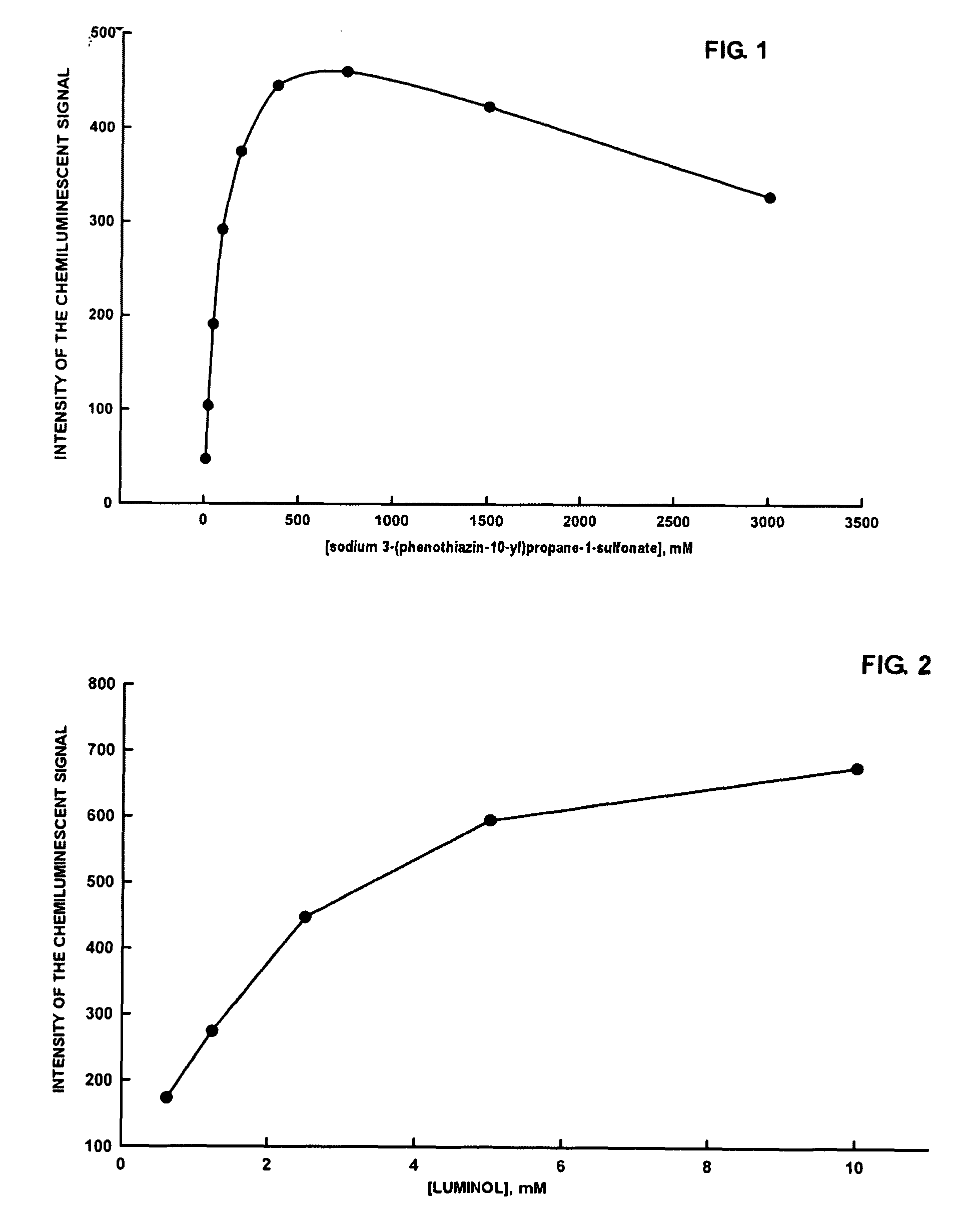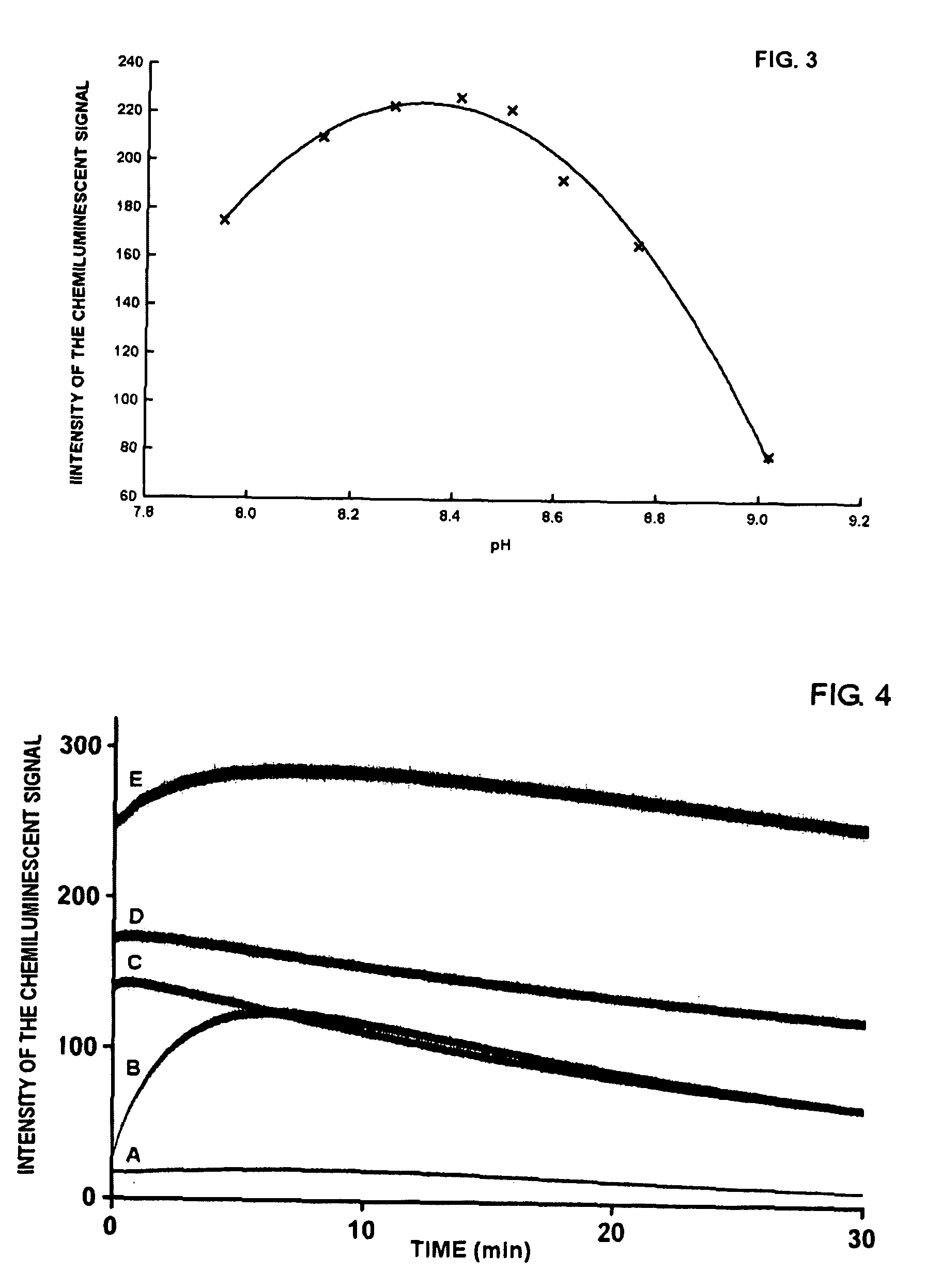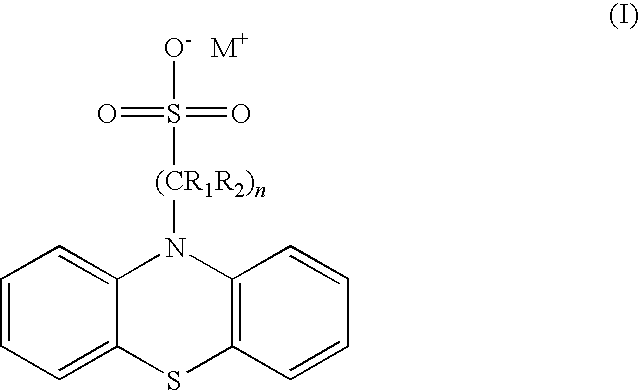Preparation of high purity phenothiazine N-alkylsulfonates and their use in chemiluminescent assays for the measurement of peroxidase activity
a technology of phenothiazine and nalkylsulfonates, which is applied in the field of phenothiazine nalkylsulfonates and their use in chemiluminescent assays, can solve the problems of large use of expensive chromatographic methods, difficult to obtain products according to current procedures, and relatively high cost of compounds. achieve the effect of high yield and exceptional purity
- Summary
- Abstract
- Description
- Claims
- Application Information
AI Technical Summary
Benefits of technology
Problems solved by technology
Method used
Image
Examples
example 1
Synthesis of sodium 3-(phenothiazin-10-yl)propane-1-sulfonate
[0038]A portion of sodium hydride (17.7 g, 0.44 moles) dispersed in mineral oil is first washed with petroleum ether (b.p. 40-60° C.) and then suspended in 200 mL dry tetrahydrofuran, in a 2 L three-neck flask. A solution of phenothiazine (80.0 g, 0.4 moles) dissolved in tetrahydrofuran (400 mL) is added under argon through a cannula. The mixture is shaken, always under argon, for one hour at room temperature and then for 30 minutes at 50° C. The mixture acquires an orange colour, following the formation of the phenothiazine anion. After the suspension has cooled to 0° C., a solution of 1,3-propanesultone (35 mL, 0.4 moles) in tetrahydrofuran is added also through a cannula. The colour of the mixture changes almost immediately to clear yellow. The mixture is stirred at 0° C. for thirty minutes after the addition of the sultone and then at room temperature for another thirty minutes.
[0039]During this period, the mixture bec...
example 2
Synthesis of sodium 4-(phenotiazin-10-yl)butane-1-sulfonate
[0040]The synthesis of sodium 4-(phenotiazin-10-yl)butane-1-sulfonate is similar to that described in the previous Example. The only difference lies in that a solution of 1,4-butan sultone (41 mL, 0.40 moles) in tetrahydrofuran (200 mL) is used instead of the solution of 1,3-propanesultone. Again, the product, sodium 4-(phenotiazin-10-yl)butane-1-sulfonate, crystallizes from the reaction mixture. Yield: 122.4 g (85.6%). The product is already of high purity. In particular, chromatographic analysis (HPLC, λ=254 nm) shows that the content of phenothiazine in the product is less than 0.0002 parts (mole / mole).
[0041]Molecular mass (C16H16NaO3S2): 357.42. 1H NMR (300 MHz, D2O) δ: 6.9-7.1 (m, 4H, ArH), 6.7-6.9 (m, 4H, ArH), 3.7 (t, 2H, —CH2—N, J=9.9 Hz), 2.5 (t, 2H, —CH2—SO3Na, J=11.2 Hz), 1.5-1.8 (m, 4H, —CH2—C2H4—CH2). Molecular mass of the free acid (C16H17O3S2): 335.44. MS (API-ES): 336.3[MH]+.
example 3
Dependence of the luminol-peroxide-peroxidase reaction on the concentration of sodium 3-(phenothiazin-10-yl)propane-1-sulfonate
[0042]All measurements reported in Example 3 were carried out with a spectrofluorimeter (Varian Eclipse), Bio / Chemiluminescence Mode (wavelength of emission: 425 nm; emission slit: 20 nm). A series of substrates in 0.1 M, pH 8.6 Tris Buffer is prepared, with the following compositions:[0043][luminol sodium salt]=2.50 mM[0044][sodium perborate]=2.00 mM[0045]3-(phenothiazin-10-yl)propane-1-sulfonate=11.5 μM, 23 μM, 47 μM, 94 μM, 188 μM, 375 μM, 1500 μM e 3000 μM.
[0046]To a polymethylmethacrylate fluorimetry cuvette of containing 2 mL of each substrate, is added 10 μL of a solution of 0.5 μg / mL of horseradish peroxidase (HRP-Type VIIA). After mixing the solution with a vortex for a few seconds, measurement of the luminescent signal is initiated. In all cases the chemiluminescent signal reaches a plateau within a few minutes, and then remains stable for at least...
PUM
| Property | Measurement | Unit |
|---|---|---|
| pH | aaaaa | aaaaa |
| temperature | aaaaa | aaaaa |
| temperature | aaaaa | aaaaa |
Abstract
Description
Claims
Application Information
 Login to View More
Login to View More - R&D
- Intellectual Property
- Life Sciences
- Materials
- Tech Scout
- Unparalleled Data Quality
- Higher Quality Content
- 60% Fewer Hallucinations
Browse by: Latest US Patents, China's latest patents, Technical Efficacy Thesaurus, Application Domain, Technology Topic, Popular Technical Reports.
© 2025 PatSnap. All rights reserved.Legal|Privacy policy|Modern Slavery Act Transparency Statement|Sitemap|About US| Contact US: help@patsnap.com



